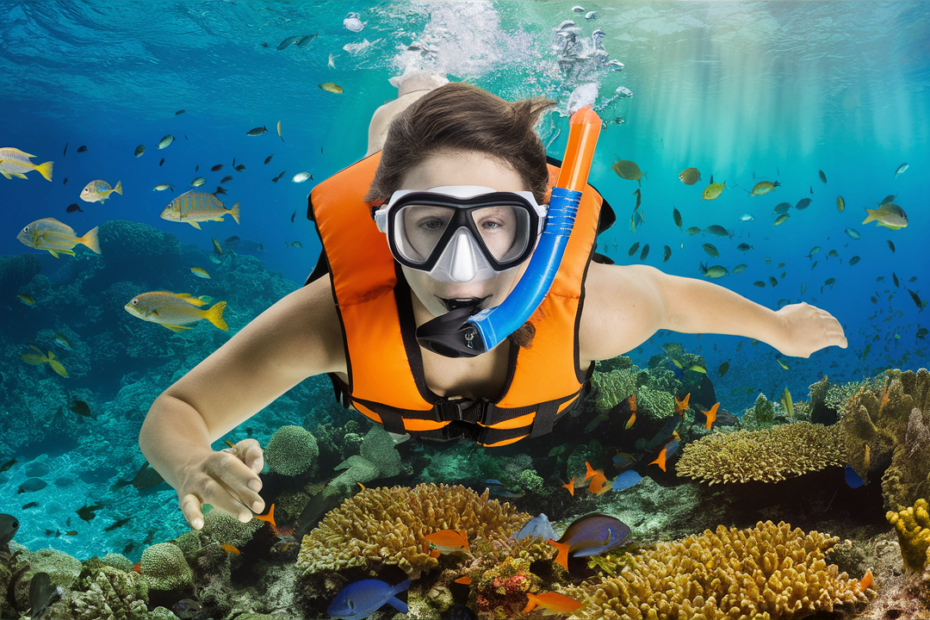Are you ready to explore the vibrant underwater world of snorkeling? This exhilarating activity allows you to witness marine life up close in its natural habitat. Whether you’re a complete beginner or looking to refine your skills, this comprehensive guide will equip you with essential knowledge about snorkeling equipment, techniques, and safety practices. You’ll learn how to choose the right gear, master proper breathing and swimming techniques, and stay safe while enjoying the wonders beneath the waves. By the end of this article, you’ll have the confidence to embark on your own snorkeling adventure and unlock the secrets of the sea.
Snorkeling Gear Essentials: Mask, Snorkel, and Fins

Mask
Your snorkeling mask is crucial for clear underwater vision. Choose a mask that fits snugly around your face, creating a watertight seal. Look for tempered glass lenses and a silicone skirt for comfort and durability. Before purchasing, perform a suction test by placing the mask on your face without the strap and inhaling through your nose. If it stays in place, you’ve found a good fit.
Snorkel
The snorkel allows you to breathe while floating face-down on the water’s surface. Opt for a model with a comfortable mouthpiece and a purge valve for easy clearing. Modern snorkels often feature a dry-top design, which helps prevent water from entering the tube when submerged.
Fins
Fins enhance your swimming efficiency and speed, conserving energy during longer snorkeling sessions. Choose between full-foot fins for warmer waters or open-heel fins with booties for colder conditions. Ensure your fins fit comfortably without causing blisters or cramping. Shorter fins are ideal for beginners, offering greater maneuverability in shallow waters.
Remember, properly fitting gear is essential for a safe and enjoyable snorkeling experience. Take the time to select and test your equipment before your underwater adventure.
Snorkeling Techniques: Proper Breathing, Diving, and More
Mastering Proper Breathing
When snorkeling, proper breathing technique is crucial for a comfortable and enjoyable experience. Begin by placing the mouthpiece between your teeth and lips, ensuring a secure seal. Breathe slowly and deeply through your mouth, allowing the snorkel to channel fresh air. Remember to relax and maintain a steady rhythm to conserve energy and prevent hyperventilation.
Diving and Equalization
As you dive beneath the surface, you’ll need to equalize the pressure in your ears. To do this, gently pinch your nostrils and blow out while keeping your mouth closed. This technique, known as the Valsalva maneuver, helps prevent discomfort and potential ear damage. Practice equalizing at shallow depths before attempting deeper dives.
Efficient Movement and Conservation
To move efficiently through the water, use long, steady fin strokes rather than rapid kicks. Keep your arms close to your body to reduce drag and conserve energy. When observing marine life, try to remain as still as possible to avoid disturbing the underwater ecosystem. By mastering these techniques, you’ll enhance your snorkeling experience and prolong your time in the water.
Snorkeling Safety Tips: Buddy System, Checking Conditions, and Avoiding Hazards
When embarking on a snorkeling adventure, your safety should be the top priority. Implementing these essential safety measures will help ensure a secure and enjoyable experience in the water.
The Buddy System
Always snorkel with a partner. The buddy system provides an extra layer of safety, allowing you to watch out for each other and respond quickly in case of emergencies. Establish clear communication signals before entering the water and maintain visual contact throughout your excursion.
Checking Conditions
Before you dive in, assess the water and weather conditions. Check local forecasts for wind speed, wave height, and currents. Familiarize yourself with tide schedules and avoid snorkeling during strong tides or rough seas. Pay attention to any warning flags or signs posted at the beach.
Avoiding Hazards
Be aware of potential dangers in your snorkeling environment. Stay clear of sharp coral reefs and rocky areas to prevent cuts and scrapes. Avoid touching or disturbing marine life, as some species can be harmful if provoked. Keep a safe distance from boat traffic and designated swimming areas. If you encounter strong currents, remain calm and swim parallel to the shore until you’re out of the current’s path.
Conclusion
As you embark on your snorkeling adventure, remember that proper equipment, techniques, and safety precautions are essential for an enjoyable experience. By following the guidelines outlined in this article, you’ll be well-prepared to explore the underwater world safely and confidently. From selecting the right mask and fins to mastering breathing techniques and respecting marine life, you now have the knowledge to make the most of your snorkeling excursions. Whether you’re a beginner or looking to refine your skills, snorkeling offers a unique opportunity to connect with nature and create lasting memories. So gear up, dive in, and discover the wonders that await beneath the surface.




Pingback: How Does a Snorkel Work? The Science Behind Snorkeling - sports to know